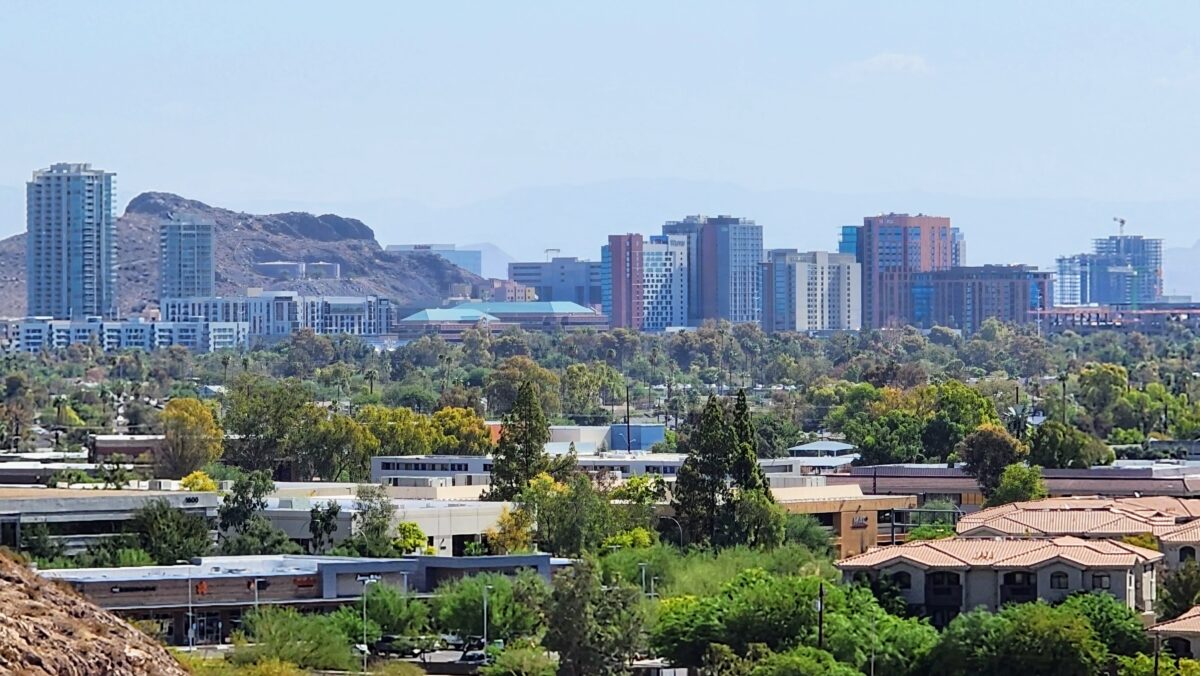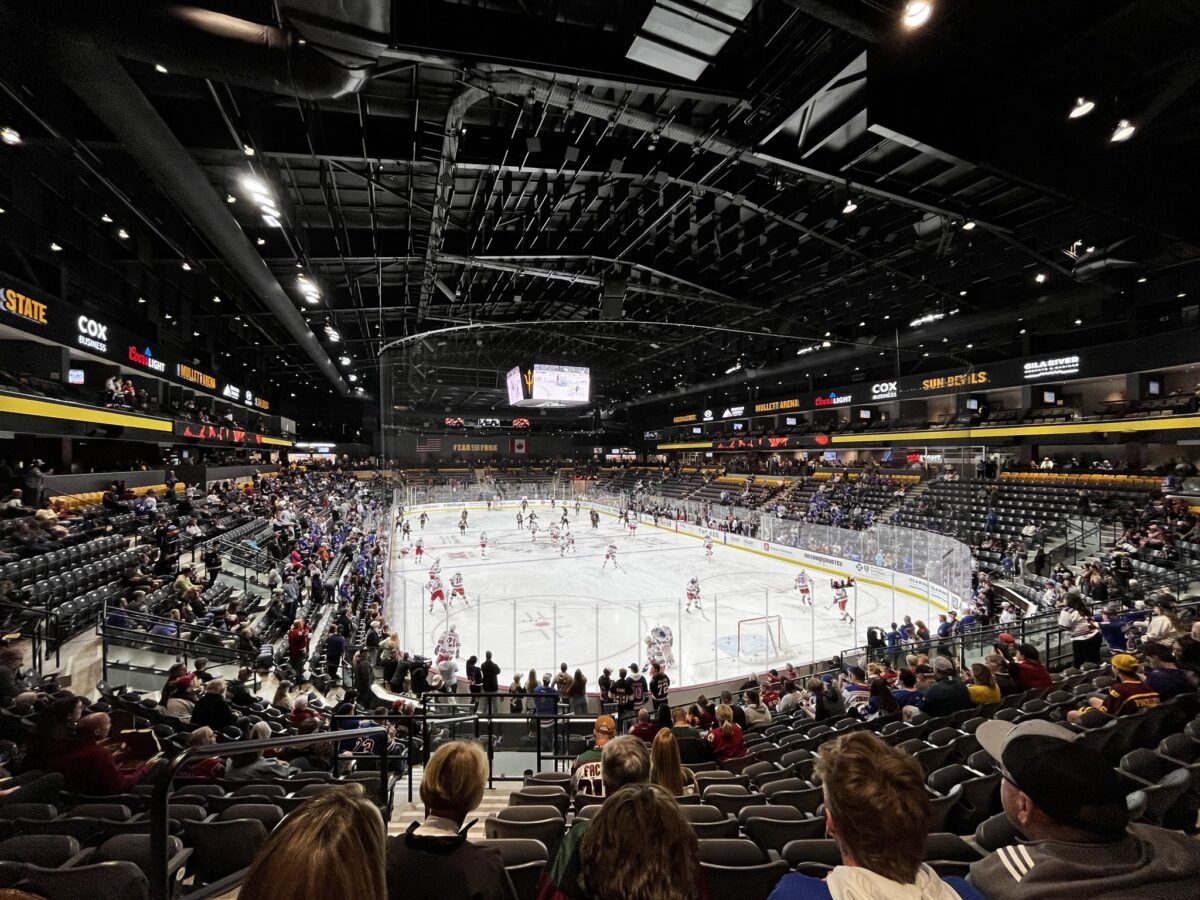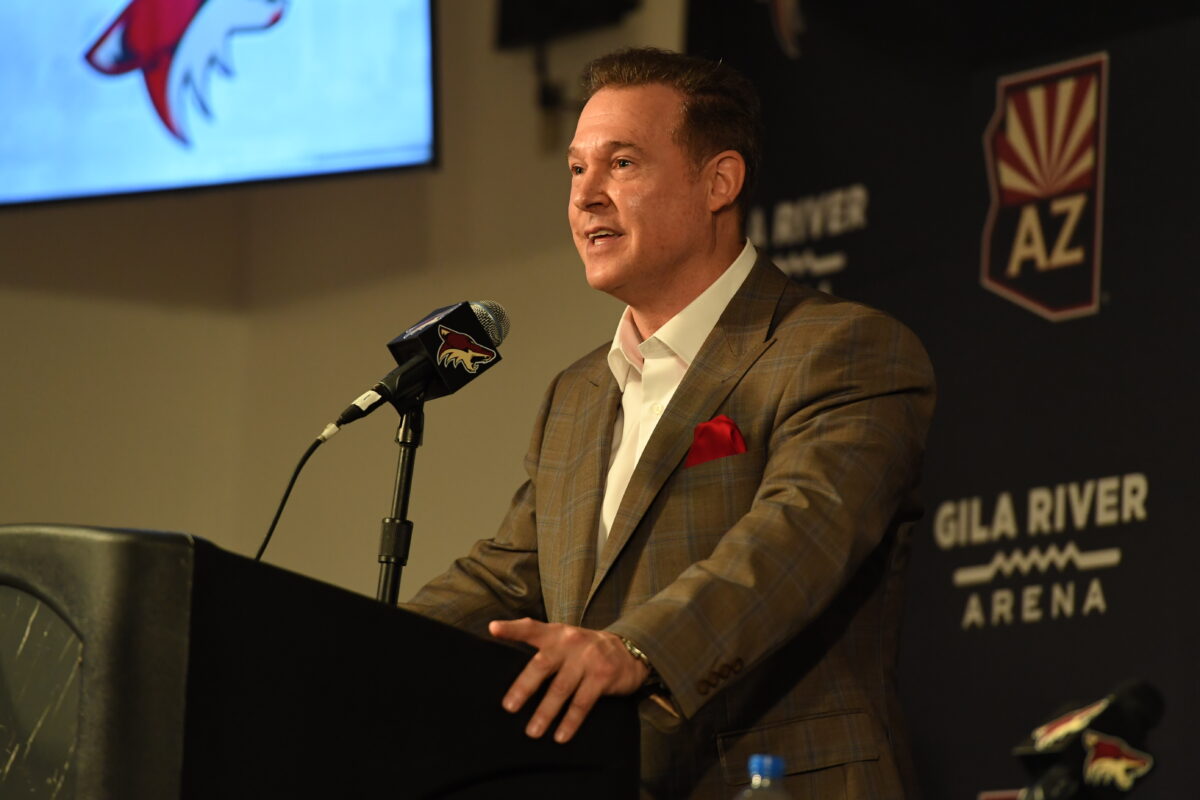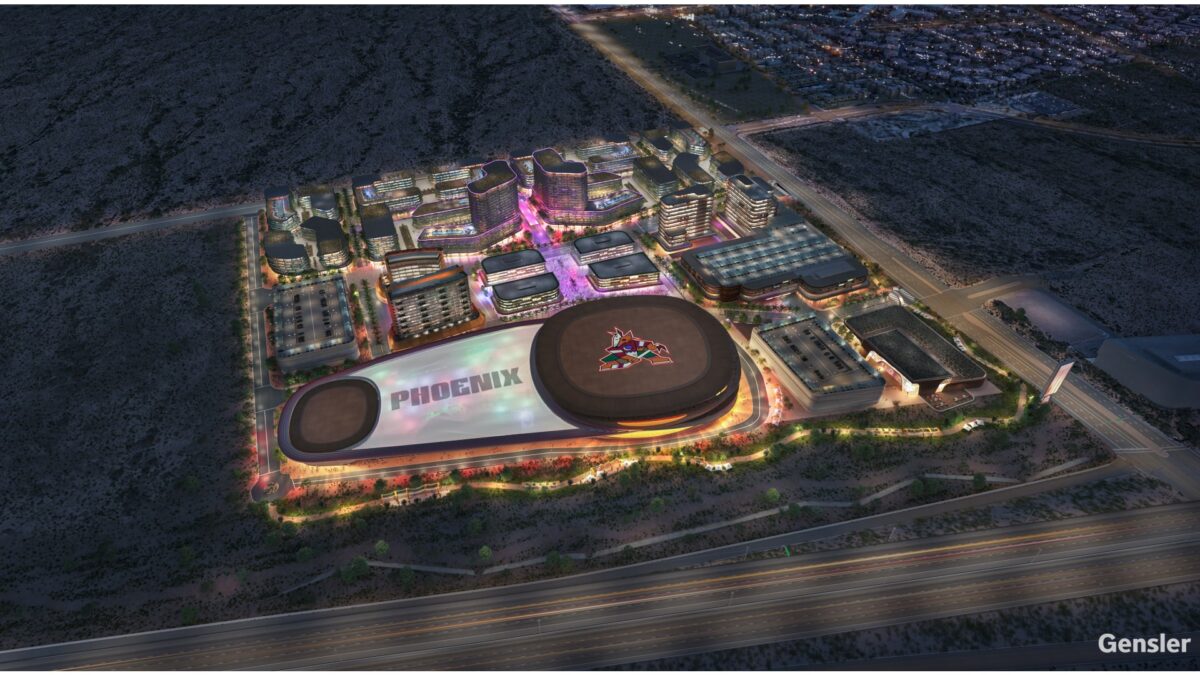July 23, 2021 was a significant date for hockey fans in Arizona. It was the day the rumor came out that the Arizona Coyotes were looking at land in Tempe to build a new arena. It was a long time coming for the franchise’s fans as the team had been through numerous owners and relocation threats. The proposal was supposed to end the question of whether the team would stay in Arizona. It was also supposed to be a new era for the City of Tempe which has become a rapidly growing city. However, little did anyone know that in just under two years, the Coyotes would be gone, and the state of Arizona for the first time since the 90s would no longer be a Big Four sports market. This is the story of the Tempe Entertainment District. What was supposed to be the saving grace for the NHL in Arizona turned into its final nail in the coffin.
The Proposal
On July 23, the Arizona Republic reported that the Coyotes were eying land in Tempe and that the Tempe city council wanted a team to build an arena on a city-owned 46-acre plot of land on North Priest Dr and West Rio Salado Parkway. The land was being used as a toxic landfill and had been used as a landfill for the past 70 years.
Early reports said that Coyotes’ owner Alex Meruelo would privately fund the project and that no taxpayers would pay a single dollar to help pay for it (the exception being if said taxpayers purchased food, merchandise, etc in the entertainment district if built). It wouldn’t just be a hockey arena though. It was set to be a whole entertainment district complete with restaurants, stores, and apartments that would help in the growth of the City of Tempe. It was supposed to be an area that wouldn’t just be used during the hockey season but 365 days a year. A sportsbook would also have been constructed in the district to help pay for the project.
Related: Comparing Coyotes Owner Alex Meruelo to NHL Utah Owner Ryan Smith
It hadn’t been unheard of before of Tempe cleaning up some of its land to help build a vital part of the city. The Tempe Marketplace was once a 130-acre toxic landfill. Developers and the City of Tempe worked together to clean up the area which ended up being the largest toxic cleanup in the state of Arizona. What followed was one of Arizona’s biggest and most popular shopping malls. A place that is frequented by many with over 100 stores (including the closest Target to Arizona State University), a concert venue, and a movie theatre. A crown jewel in Tempe.
At this point, the Coyotes had called Gila River Arena home since 2003. While the actual arena was a decent venue, the problem was that it was located in Glendale. Back in 2003, Glendale was expected to be the next big city in Arizona with the NFL’s Arizona Cardinals eventually joining the Coyotes. However, the city never exploded like it was supposed to and most fans found themselves driving 30 minutes if lucky from Phoenix, Mesa, Tempe, and Scottsdale to the arena.
It was no secret that the Coyotes wanted and needed to get out of Glendale. The city and the team had been on a year-to-year lease agreement. The attendance numbers weren’t fantastic for the team either. It had reached a boiling point when NHL commissioner Gary Bettman publicly stated that Glendale was not suitable for the league and the Coyotes.
“For the past 15 years, a succession of ownership groups and the league have tried everything imaginable to make the Glendale location financially sustainable,” Bettman said. “Our combined efforts have yielded the same result — a consistent economic loss. The simple truth? The Arizona Coyotes must have a new arena location to succeed. The Coyotes cannot and will not remain in Glendale.”
It came to a breaking point in August 2021 when the City of Glendale chose to terminate the Coyotes’ lease at the arena after the 2021-22 season. Stalled negotiations between the two sides were cited as the main reason why the lease was terminated but the Coyotes’ history with managing their finances also played a role in the choice. It put the team in a tricky spot with no other NHL-approved venue in the Valley.
“We are thankful to the NHL and the Arizona Coyotes for being part of the Glendale community for the past 18 years,” Glendale City manager Kevin Phelps said in a statement. “The decision not to renew the operating agreement with the Coyotes was not made overnight or in a vacuum. We carefully weighed input from key stakeholders, our expert economist, our arena management firm and our city council.”

The next month, the Coyotes officially submitted their bid for the land which would be reviewed by the Tempe City Council. During the 2021-22 season, more information came out about the project. The team announced they would be paying $2.1 billion all out of Meruelo’s pocket to clean up the land and build the district. It would also bring 6,000 new jobs along with more tax revenue for the whole city thanks to the increased interest in visiting the area.
Late into the season, the Coyotes were still seeking out their new temporary arena for the next three seasons while the proposed Tempe arena was being built. The two finalists were the Veteran’s Memorial Coliseum and Mullett Arena. The Coliseum had the potential to have a bigger capacity with around 10,000 seats compared to 4,600, but the Coliseum had no luxury boxes. The historic arena also needed extensive renovations including a new ice plant and repairs to the floor, roof, and seating, which all add up, costing Meruelo millions of dollars.
Meanwhile, Mullett Arena, which was a brand new arena for the ASU’s NCAA hockey team, was under construction on the Tempe campus. While it would be way smaller than the Coliseum, it offered luxury boxes, Zambonis, and an ice plant. The upgrades the Coyotes would have to make would be the addition of a two-story annex complete with two NHL-suitable locker rooms, workout rooms, and other necessary amenities for an NHL team. In the end, due to the location and the viability of the situation, the Coyotes chose to move into Mullett Arena in February 2022.
“We are thrilled that we have arranged to play our home games in Arizona State University’s new multi-purpose arena starting next season,” Coyotes president and CEO Xavier Gutierrez said. “This will be an incredible, intimate, and exciting fan experience in a state-of-the-art new arena in a fantastic location in the heart of Tempe.”
On June 2, the Tempe city council voted 5-2 to continue negotiations with the Coyotes for the purchase of the landfill after an eight-hour session. During the session, Shane Doan, Clayton Keller, Lyndsey Fry, and Gary Bettman all appeared and voiced their support for the project.
The Coyotes and their development group, Bluebird, also publicly opposed the Phoenix Sky Harbor Airport and the City of Phoenix’s threats against the team and the City of Tempe in their opposition to the Tempe Entertainment District project. The airport filed legal action against the City of Tempe due to concerns about the noise contour in the new district. The legal complaint claimed that Tempe had breached the 1994 agreement between the two cities to keep residents in the flight path of the airport safe from noise. The airport and the City of Tempe have had numerous battles over the cities’ history over the growth of Tempe including the construction of skyscrapers. This was another chapter in the ongoing battle between the two sides.
“Their lawsuit is a complete fabrication and it is a political document, not a legal one,” said former Tempe mayor Hugh Hallman.
Sky Harbor also sent 100,000 flyers out to residents of Phoenix, Scottsdale, and Tempe, saying the airport might create new flight paths over new neighborhoods causing new noise complaints. At this point in time, the Tempe Entertainment District project was not approved by the city council, provoking Tempe Mayor Corey Woods.
“I reject this alarmist tactic,” he said. “Our region is known for collaboration and responsible action. It is unprecedented for a neighboring city to stuff mailboxes with its opinion about an unapproved development project.”
Discussions went on between the two sides. The Coyotes and Meruelo’s financial stability and information were shared with the city council. Renderings of the whole entertainment district were released shortly after the city council approved continued negotiations revealing a beautiful arena, multiple business and retail buildings, and a community rink.
“This proposed project we believe represents the very best,” said Bettman. “It will be transformative not just for the franchise, and for our league, but also for the City of Tempe.”
Months passed as summer turned to fall awaiting the November council meeting where the fate of the project would be decided. The project had to pass the city council’s approval of three items: a development and disposition agreement, a general plan amendment, and a zoning agreement to move on to the next stage of potential approval.

On Nov. 30, the city council approved all three items and voted 7-0 to send the project to a public vote that would take place on May 16. It was here where the story of the Tempe Entertainment District took its most controversial turn that would significantly influence the May 16 vote. Either way, it was clear that if the project was approved, it would change Tempe.
“If you look at Tempe Town Lake, it’s the second largest attraction in the state behind the Grand Canyon, with about two and a half million visitors per year,” Tempe Chamber of Commerce president and CEO Colin Diaz said. “This project is predicting three million a year. Obviously, some of those will be overlapped, but a long time ago, there were talks about whether it made sense to extend the lake west. I think a project like this means it would make sense over time, and then when you have bookend activity on the east and west ends of the lake, you’d start to see more of an emphasis on activating that space, which helps in a lot of ways. It helps with keeping people and dollars in the region longer, it helps with having something for everybody, and it helps with the vibrancy of the region.”
The Vote
From the Nov. 30 vote came two different parties. Tempe Wins and Tempe 1st. Tempe Wins was a group headed by the Coyotes and Bluebird supporting the Tempe Entertainment District. Political allies included city council member Randy Keating and Mayor Corey Woods. Numerous past Tempe mayors also voiced their support for the project.
“We have argued almost more than anyone else could in this room – vehemently – and when you get the four of us on the same side of an issue, you absolutely know that’s the right thing to do,” Former Tempe Mayor and development supporter Hugh Hallman said, pointing to the other three mayors in attendance at a Tempe Wins rally.
Meanwhile, the Tempe 1st program was against it. Its main issues were Meruelo’s past, the money concerning the project, and how it would impact Tempe. Political allies included former city council member Lauren Kuby.
The two parties organized their campaigns very differently. Tempe 1st played a very dirty and aggressive campaign. The campaign relied heavily on exploiting Meruelo’s not-so-great financial history, often making signs exposing the owner, and the motto “Don’t give tax breaks to billionaires”, claiming Meruelo would be taking money from taxpayers.
Tempe 1st relied heavily on some misleading and untrustworthy media sources like ASU’s State Press who opposed the Tempe Entertainment District. The news organization was recently slammed for posting 24 AI-generated stories.
The Tempe 1st campaign also claimed if the district failed, a park would be built in its place. The claim went viral with a graphic of a cartoon drawing of Xavier Gutierrez saying “Who wants parks when you can get 2 casinos? It’s my Tempe now kid!”
Perhaps the most infamous moment during the campaign was the vandalization of a Goodwill. The morning before a press conference with Bettman that was being held at a Goodwill location, a Tempe 1st supporter chalked up all the parking spots writing “vote no.” The press conference was moved to a different location and Gutierrez spoke out about the incident.

“Last night the Goodwill site in Tempe that we had originally scheduled to be at was vandalized,” Gutierrez said. “We are incredibly disappointed, we are incredibly angry by those actions and they were clearly the actions of critics and opponents of this campaign.”
There are many more stories and actions that Tempe 1st did in their campaign. However, what they did successfully was do anything they could to win the campaign. They lied to the senior citizens in the area who regretted voting the way they did shortly after the vote. They utilized a handful of Arizona State’s student body. They created strong and harmful signs and political cartoons that were ultimately effective. The strongest tactic of them all was tearing apart Meruelo and his past, painting him as the ultimate villain to Tempe which would be a fatal move for the Tempe Wins organization in the future.
Tempe Wins ran a horrible campaign and there’s no getting around that. Instead of constantly attacking the opposition and spreading the truth that Meruelo was paying for the whole project, they relied on videos from rallies, thinking they could win the vote while simply coasting to May 16. It wasn’t until late into their campaign they posted videos on social media exposing Tempe 1st supporters going door-to-door spreading misinformation on the project.
The Coyotes and Tempe Wins had everything they needed to win an election in their hands. The power to transform a toxic landfill into an entertainment district for free was never really strongly conveyed to the public along with their other plans including the contribution of $2 million to the Tempe Coalition for Affordable Housing. Despite having a relationship with Arizona State, the campaign never utilized the university’s students and news outlets to gain votes.
“I have talked to a couple other staff members and we’re all of the thought that they’re (Tempe Wins) just kind of late to the game in putting out the information that they need to be putting out to counteract all the stuff that has been going around,” one Tempe official said. “The ‘no’ campaign has been out for a long time. That’s what seems to work here in Tempe really well. The sooner you get out and get the information out, the better.”
In April, the drama between Phoenix and the Tempe Wins campaign continued as the Coyotes sued the city of Phoenix for $2.3 billion for trying to “sabotage” the district project after Phoenix sued Tempe. While nothing big came from the two lawsuits, it gave Tempe 1st more ammo to use against their foes.
On May 16, voters gathered to decide the future of Tempe. Three different propositions would have to be approved in order for the Tempe Entertainment District project to go through. Propositions 301, 302, and 303. The Coyotes and the Tempe Wins campaign held a party awaiting what they expected to be a slam dunk win.
What transpired was the worst possibility for the Coyotes and the Tempe Wins campaign. All three of the votes failed miserably. Even worse, only 29,153 people voted. 90,000 people are registered to vote in Tempe.
“We are very disappointed,” Gutierrez said after the results came out. “What is next for the franchise will be evaluated by the owners and the National Hockey League over the next few weeks.”
It was a complete failure for the Coyotes and the Tempe Wins organization. It was expected to pass. Instead, it would ultimately be the reason why the team would leave Arizona.
Conclusion
In the coming weeks, the Coyotes released a statement that they were committed to staying in Arizona. The team released a letter of intent to purchase land in Mesa. However, that never went anywhere, at least publicly. Later, the Coyotes announced their intentions to purchase land in north Phoenix. Unfortunately, time had run out for the team. Two weeks later, it was announced that hockey operations would be transferred to Ryan Smith, owner of the Utah Jazz, who relocated them to Salt Lake City.
The landfill in Tempe to this date is still a toxic landfill. There have been no plans to remediate the land into a park. Any future plans will most likely cost the Tempe taxpayers money.
Meruelo after selling the Coyotes listed the Tempe failure as the main reason why the team relocated. The billionaire also claimed he spent $7 million on the Tempe Wins campaign. Keating, who was once a supporter of Meruelo, called out the former NHL owner, saying he only spent $1.1 million on the campaign with public records backing him up.

In the end, the Tempe Entertainment District was a massive failure for the Coyotes, Tempe Wins, and Meruelo. The campaign advocating for the district was horribly executed despite having an abundance of resources to win it. They allowed Tempe 1st to viciously attack Meruelo and the project and lie to citizens. It was a lazy attempt that really didn’t do much to help their case until it was too late.
“My biggest disappointment is that the referendum failed in Tempe,” Bettman said. “I’ve never seen a more public-private win-win than that was. The landfill is still there and it’s gonna be there for a long time. There was an opportunity for it to be funded privately and cleaned up. That disappointed me more than all the things we’ve had to deal with in the past 27 years.”
Ultimately, the Tempe Entertainment District is a blueprint for sports franchises in every league on how not to run a public campaign advocating for a new sports facility. The numerous failures cost Arizona a new landmark and eventually their NHL team. So many things could’ve been done differently in attempts to secure a win for the Tempe Wins campaign. However, it wasn’t. In 28 years full of controversy and failures, the Tempe Entertainment District will go down as the biggest failure in the Coyotes franchise. Even one day when the NHL comes back to the state, May 16, 2023 will forever be a scar on Arizona’s hockey history.